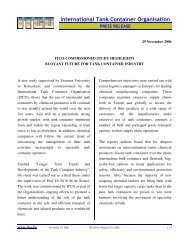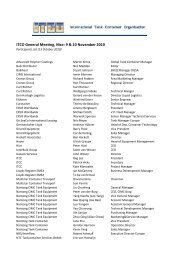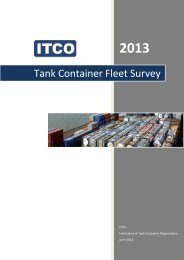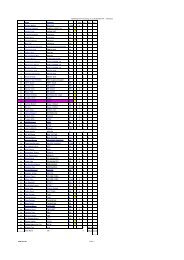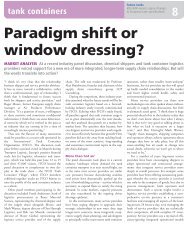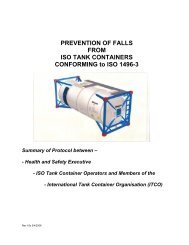Create successful ePaper yourself
Turn your PDF publications into a flip-book with our unique Google optimized e-Paper software.
ICHCA International <strong>Safe</strong>ty Panel Briefing Pamphlet No 30<br />
4.2 Pressurised Liquefied Gases<br />
4.2.1 <strong>Tank</strong> containers for pressurised<br />
liquefied gases usually have a mild<br />
steel pressure vessel shell. A few<br />
specialised tank containers for<br />
these gases may have a stainless<br />
steel shell.<br />
4.2.2 Where high ambient temperature or<br />
direct sunlight can affect the cargo<br />
then a heat shield can be fitted<br />
above the top <strong>of</strong> the pressure<br />
vessel (see Picture 13)<br />
Picture 13<br />
4.2.3 Rarely for tank containers, the pressure vessel shell may be totally uninsulated.<br />
4.3 Powders and Granules<br />
4.3.1 <strong>Tank</strong> containers for powders and<br />
granules are generally low<br />
pressure vessels manufactured<br />
from aluminium alloys. An example<br />
is shown in picture 14.<br />
4.3.2 The nature <strong>of</strong> the powder or<br />
granule will dictate the design as<br />
will the loading / unloading process<br />
in which the tank container is to<br />
operate.<br />
4.3.3 The discharge process for powders and granules differs from liquids and<br />
gases insomuch as the cargo may not “flow”. Therefore tank containers for<br />
powders and granules may be manufactured with hopper discharge chutes<br />
built along the underside <strong>of</strong> the shell, or with specialist discharge<br />
mechanisms which facilitate the discharge.<br />
4.3.4 <strong>Tank</strong> containers that carry powder and granules may be mounted on tipping<br />
chassis / trailers<br />
4.4 <strong>Tank</strong> <strong>Containers</strong> for Deeply Refrigerated Liquefied Gases<br />
4.4.1 Some tank containers are designed and constructed to transport liquefied<br />
gases at extremely low temperatures, at around –200 o C or lower. They may<br />
be referred to as “cryogenic tanks” within the freight container industry.<br />
Picture 15 shows an example <strong>of</strong> a 20 ft cryrogenic tank<br />
4.4.2 Due to the nature <strong>of</strong> the<br />
cargoes carried the level <strong>of</strong><br />
insulation varies A typical<br />
cryogenic tank container will<br />
have an outer metal jacket<br />
surrounding the pressure<br />
vessel. A near-perfect<br />
vacuum is created between<br />
the outer metal jacket and<br />
the pressure vessel; this<br />
provides the insulation.<br />
Picture 14<br />
Picture 15<br />
Page 8 ©ICHCA International Limited



